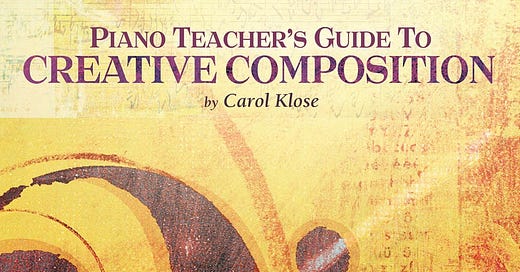This book is the essential guide to teaching elementary composition
A review of Carol Klose's 'Piano Teacher's Guide To Creative Composition' – a comprehensive and engaging resource for teaching composition to beginners
When you’re first getting started at teaching composition and improvisation, it can feel like there are very few good quality resources out there, especially for teaching composition to beginners.
But as I’ve dived deeper into publishers’ back catalogues, I’ve come across some wonderful books that were published a decade or more ago. One of the main reasons I started this site was to share some of them with a new audience.
Carol Klose’s excellent Piano Teacher’s Guide To Creative Composition is one such book. Published back in 2011 by Hal Leonard, just a couple of years before the author passed away, it’s an accessible and clearly-written resource that you will find useful both in the short-term and long-term.
If you could only afford one book about teaching composition in piano lessons, Carol Klose’s Piano Teacher’s Guide to Creative Composition is the one you should get.

The book excels in many ways:
Klose’s text is a very clearly written and has a charming, personable style
The depth of both theoretical knowledge and practical experience on display is remarkable. Alongside the many ideas there are often anecdotes about how they have been used with Klose’s own students
The book is very well structured (which I’ll explore more below)
You’ll find it useful both now—there are detailed lesson plans that you could begin using tomorrow—and long into the future. The first chapter in particular contains a wealth of ideas that I sometimes refer to when a student and I have got stuck
What’s inside…

After an encouraging introduction, “Part One: Laying The Groundwork For Creative Composition” gives a vast array of ideas for how to get students started with composing. It’s a really valuable reference guide. I particularly like the subsection “Preparing the ear for daring musical ideas: beyond “I-IV-V-I”, which has often proved to be a valuable source of inspiration in my lessons.
“Part Two: Student’s Library Of Compositional Tools” begins with a useful but dry list, and closes with an excellent subsection on how to explain compositional terms to the student. The comparisons to architecture are astute, but the descriptions of texture are particularly wonderful, managing to be both smart and amusing. Klose was evidently an excellent communicator, particularly to children.
“Part Three: Mapping A Composition” explains how best to get a student to think about the emotional landscape of a piece. This is a really useful activity, which I’ve used many times in my lessons. “Part Four: Lesson Plans” is exactly that, a simple set of well-planned activities. These are really good, especially if this is your first time teaching composition in a lesson.
“Part Five: Refining A Composition” gives suggestions for improving student compositions. This is a useful but with a length of only 15 pages, it ultimately fails to cover the many adjustments you learn to recommend as you become a more experienced composition teacher. Even so, it is a good starting point and is well worth reading if you are teaching composition for the first time.
Conclusion
Carol Klose’s has us a legacy to cherish in the Piano Teacher’s Guide To Creative Composition. It makes a really valuable investment, particularly for teachers who are just getting started with teaching composition, and at around $12.99 offers good value for money. Highly recommended.
Carol Klose, Piano Teacher’s Guide to Creative Composition, Hal Leonard, 2011. ISBN: 978-1-4234-9556-7.




